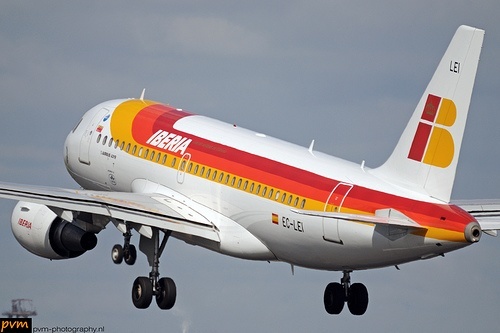Discover Spain & Spanish Culture
(photo
by MorBCN used
under terms of Creative Commons license.)
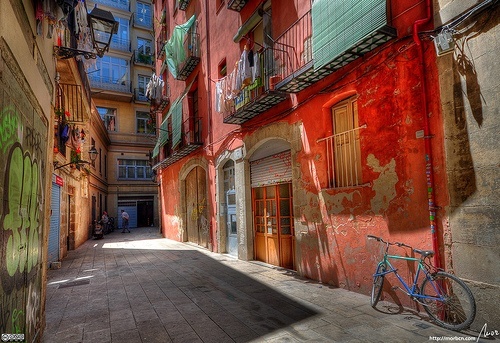
Content:
The jagged wall of the
Fifty percent of the area of
peninsular
Like its numerous mountain ranges,
(photo by José Manuel Ríos Valiente used under terms of Creative Commons license.)
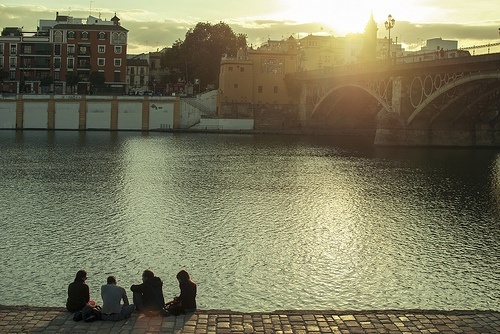
In addition to the mainland, Spanish
territory comprises the
Balearic and Canary Islands and the strategic Moroccan enclaves of
Protective mountain barriers and the warming effects of the northern gulf stream and
Mediterranean
currents moderate
Abundant year-round rainfall lends a deep-green color to northern pastures and meadowlands. Seasonal temperatures vary only slightly; winters are mild, summers, cool.
The central tableland exhibits wide climatic variations, both during the course of a single day and seasonally. Here, as in other high elevations, raw winters are characterized by snowstorms and penetrating winds. During the dry summers, many Madrileños seek relief on the more temperate coasts.
Ancient olive groves and vineyards thrive in the hot semi-aridity of southern summers. Winters are pleasant, with frosts occurring only once or twice a year.
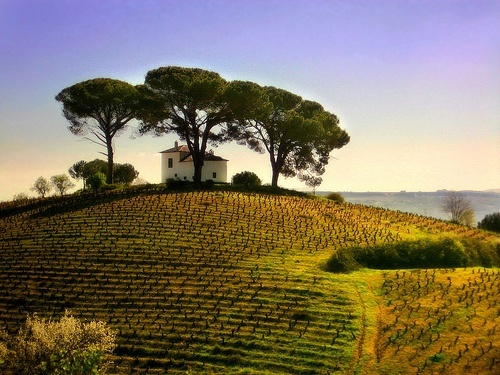
The
eastern coast and
In
- Multiply the Centigrade reading by 9
- Divide the result by 5
- Add 32
From
prehistory on, many different
peoples-- from the
Mediterranean's shores, Northern Africa and Europe--have invaded and
inhabited
Early
inhabitants, paleolithic
hunters (l5,000 B.C.) of
Around
3,000 B.C., tribal groups,
Iberians after whom the
peninsula was named, began arriving from the eastern
Also
from around the Mediterranean
came Phoenician traders
who founded
(photo
by Lorenmart used
under terms of Creative Commons license.)
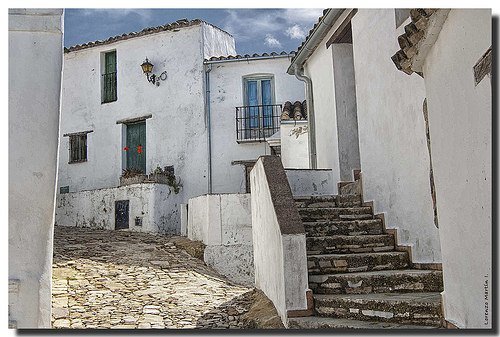
Of all
the invaders, only the Romans
were able to Conquer
most of the peninsula, which they named Hispania. In the second century
B.C.
In
711, invaders from North Africa,
the Moors of mixed
Syrian, Egyptian and Berber blood, sailed across the straits and pushed
Visigoth warriors north to the
Efforts
to drive out the Moors, known
as the Reconquest,
were unified after more than 700 years when, in the thirteenth century,
the
Catholic kingdoms of
By the
sixteenth century,
By the
seventeenth century, plagues
and unceasing military
campaigns had drained
A
century later
Neutral
in
Internal
pressures coupled with
unchecked violence led to
the outbreak of the Spanish Civil War in 1936. Following the victory of
his
Nationalist forces, General Francisco Franco ruled a nation exhausted
politically and economically.
The structure of modern Spanish and more than half its vocabulary derive from the Latin spoken during the Roman colonization of the peninsula. Words from Arabic; other European languages, notably French and Italian; and from the Indian languages of colonial settlements further enrich the vocabulary.
In a
broad sense, the term "Spanish"
is taken to
mean three of the four languages native to Spain--Castilian, Catalan
and
Galician—and their dialects. In a restricted sense, it is synonymous
with
Castilian, the official idiom used by government offices, courts, most
schools
and the media. Approximately 70 percent of the total population of
With slight modifications in usage, Spanish (Castilian) serves as the official, primary or secondary language of 250 million people in Spain; most of the Antilles; parts of Africa and North America; Mexico; Central America; South America with the exception of Brazil and the Guayanas; and, to some extent, in the Philippines among the upper classes. This important romance language, ranking third in number of speakers worldwide, also serves as one of the five official languages of the United Nations.
Dialects of Castilian include Aragonese, rich in proverbs and songs; Leonese, widely variable from village to village; and Andalusian, source of many slang words incorporated into national speech.
Catalan,
native to
Melodious
Galician, with four
dialects corresponding to
The
fourth language of
The
kitchens of
A
number of dishes, both national and
regional, are to be
recommended. Variations on rice-based paella, flavored with saffron and
pimentos, are found all over the country.
(photo
by mati-hari used
under terms of Creative Commons license.)
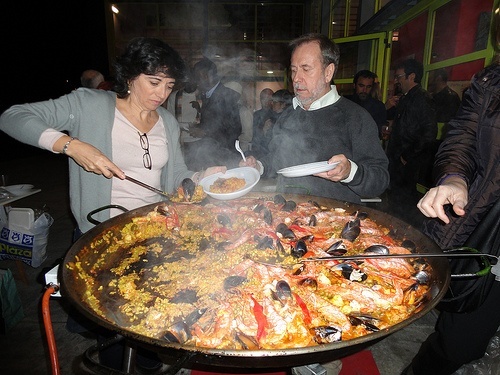
Squid
(calamares), at their best in
the Basque country and
Gazpacho is an uncooked soup of Andalusian origin. Oil and vinegar are combined with finely strained tomatoes, garlic, cucumber, green peppers and onion. Garnished with croutons, the chilled blend makes a refreshing repast on hot days.
Spanish
cooks prepare legumes in a
variety of ways.
The
meals of the Basque nation are
likely to include several
hearty courses. Salt codfish cooked with fresh tomatoes (bacalao a la
Vizcaina)
is known in other areas of
Although enjoyed at most meals, desserts are not varied. Common after-dinner treats are custard (flan) and ice cream (helado). This culinary lapse is more than compensated for by many varieties of fresh fruit: oranges, melons, grapes, dates and peaches. A serving of any of these with a piece of regional cheese, a good mild one being Manchego, marks an indulgent end to any meal.
Coffee may be ordered black (solo), with a dash of milk (cortado), or white (con leche). A large cup is a doble.
Spaniards
generally eat later than
other nationalities.
Spaniards in the South of
In hotels patronized by tourists, it is now possible to order breakfast, usually of the simple continental variety, as early as 8 a.m. (and as late as 11). Most often, lunch, the main meal of the day, is taken between 1 and 4. Restaurants begin serving dinner at 8:30 or 9 p.m. and stop at midnight.
Many cafes offer tempting snacks (tapas) for those who find it hard to hold out until scheduled meal times. Seafood is the most common, but sandwiches and several varieties of sausage can be purchased as well. With all of these, Spaniards drink wine or beer.
(photo
by Salomé Chaussure used
under terms of Creative Commons license.)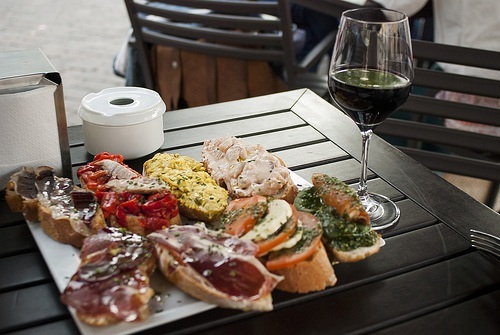
Wine
Wines as varied as the topography and climate of the country enhance the midday and evening meals of most Spaniards. Nowhere else in the world is wine so available, so strong and still so inexpensive.
The majorities of wines are regional and are found only in the area of their production.
Others
of a higher quality are sold
throughout
Many
millions of acres are under
grapes, with
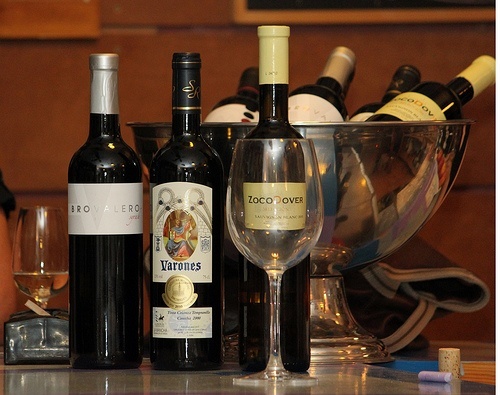
Premier
wines (reservas), mostly
reds, come from the Rioja
district north of
Others
among the better known are the
golden chacolí of the
Basque country, often hard to find because of limited production, and
the heavy
toro of
Locally produced wine (vino corriente) is sold inexpensively in wine stores'(bodegas), straight from the barrel. The house wine of restaurants (vino de la casa), served from a pitcher, is usually of reliable quality and costs less than its bottled equivalent.
Sherry
Sherry
is made only from vines grown
in the chalky soil of
the
Matured by the solera system, drawing wine from a barrel for sale and replacing it with younger wine, ensures a quality so consistent that there are no vintage years.
The three main types are finos (dry), amontillados(medium), and olorosos (sweet).
Finos and amontillados are generally aperitif wines; olorosos are taken after dinner or with dessert.
Brandies
and Liqueurs
Both domestic firms and companies under license from distilleries in other countries produce brandies (coñac) and liqueurs (licores) in huge quantities.
Brandy, a favorite drink of older Spaniards, is quite sweet. Well-known brands are Fundador, Domecq and Soberano, which is the driest of the three. Esteemed Lepanto and Carlos Primero cost considerably more.
Favorite liqueurs include Anis, served with ice; Calisay, useful as a digestive aide; and
Palo, a very sweet Majorcan drink made from figs.
Beer
San
Miguel and Aguila) can be ordered
all over the country.
Others (Málaga's
Other
Drinks
Sangria is the summer beverage favored by Madrileños. This cooling mixture is prepared with wine, water and slices of orange or lemon sweetened with sugar or liqueur.
Asturians press two grades of cider (sidra) from apples in the orchards of the North. Local cider bars (cedrerias), serve the rough and inexpensive still form by aerating it into glasses from an overhead bottle. Sidra champaña, a more refined, sparkling version, is bottled and sold in restaurants, bars and wine shops throughout the country.
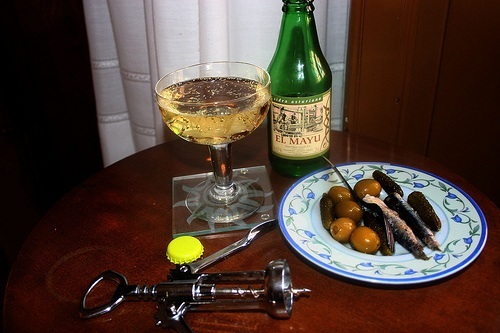
Horchata is an immensely popular nonalcoholic drink. Outdoor cafes called horchaterias specialize in serving this milk like libation made with ground earth almonds (chufas) or real almonds.
Coca-Cola, Pepsi-Cola and Fanta are widely available in bottles or in cans. Tri-Narajus, in lemon and orange flavors, is a refreshing noncarbonated drink.
Nowadays
water in
(photo
by Gaspar Serrano used
under terms of Creative Commons license.)
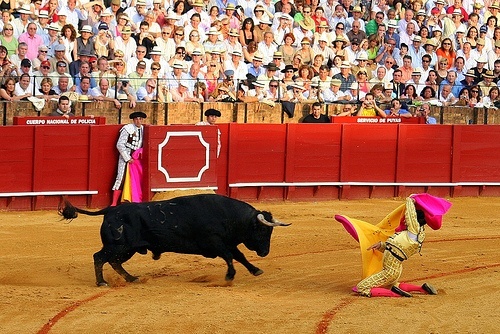
The best view of the fight, which starts in the afternoon punctually at the time announced, is from the tendidos, a section about halfway back. Seats on the sunny side of the ring sell for less than those in the shade.
The spectacle lasts about an hour and a half, or until three toreros each kill two bulls. The first part belongs to the picadores astride their padded horses. After the horsemen have provoked the bull to charge by goading him with lances, the banderillos further weaken the animal by implanting wooden sticks tipped with steel points in his flesh.
Last comes the matador, dressed in a glittering suit of lights (traje de luces), to dispatch his specially bred opponent. After playing the beast with a red cape (muleta), the matador plunges his short sword (estoque) into the neck. The first thrust, the "moment of truth," should kill.
The ancient rite of bullfighting is not a sport, nor even a physical contest between matador and bull. The test is how far a man will go to prove his courage is superior to an animal's. Spectators are cautioned not to shout encouragement to the bull.
Spaniards
are passionately interested
in sports, both those
common to the rest of
Hunting
and fishing in
Salmon
is found in many streams in
the North and trout in
abundance swim the upper reaches of almost every river. Underwater
fishing,
permitted on all coasts, is most rewarding in the
Several internationally successful players have given an impetus to the already popular game of golf. The country's 80 courses, most located in places of outstanding beauty, welcome visitors. Carts and clubs are available for rental.
Anyone with energy and an appreciation of nature has a choice of gentle or steeper gradients. Seven hundred fifty Spanish clubs, many owning mountain refuges, are devoted to hiking. All of these organizations with memberships open to climbers of any nationality, are grouped under the Federación Española de Montañismo, an affiliate of the American Alpine Club.
Every
year more and more enthusiasts
frequent the
peninsula's four main ski areas--the Spanish Pyrenees, the Cordillera
Cantabrica, the mountains around
Soccer,
called fútbol, is avidly
enjoyed, both as a
recreational activity and as a spectator sport. During the season fans
pack
(photo
by rromer used
under terms of Creative Commons license.)
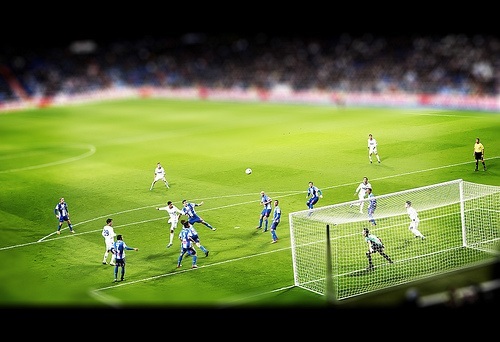
The strenuous Basque game of pelota, or jai alai, is enacted on a cement court called a fronton. The players, two on each side, wear foot-long baskets as extended gloves in which to catch the hard balls and hurl them back against a wall. A wire net protects spectators from the hundred-mile-an-hour impact of misfired balls.
Although
not as popular in
Every day Spaniards buy tickets for the national lottery from street vendors. Winners of the Christmas lottery, El Gordo, share in a 550-million-peseta pot to become instant millionaires.
A
fiesta is a holiday, in
(photo
by Juanedc used
under terms of Creative Commons license.)
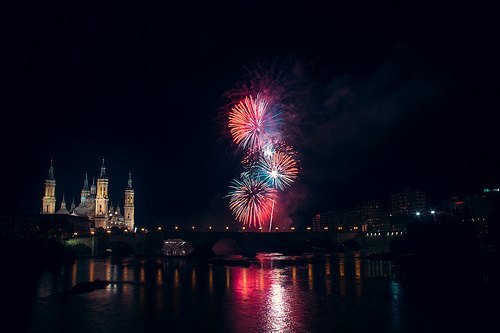
Several major festivals offering insight into the Spanish temperament are observed nationwide. On these days, bars and restaurants remain open; shops, offices and banks are closed.
1. New Year's Day. January 1. The streets are filled with noise and activity on New Year’s Eve. The following day, families enjoy a traditional meal at home.
2. Epiphany. January 6. This, more than Christmas, is the day on which the Three Kings distribute their gifts to children.
3.
At
night costumed celebrants burn
fantastic figures. The
fallas of
4.
Holy Thursday, Good Friday.
Variable dates. Holy Week is
noted for elaborate processions, especially those in
5.
6. Labor Day. May l. Officials recognize Contributions made by working people.
7.
8.
Saint James' Day. July 25.
Pilgrims journey to the tomb
of
9. Assumption Day. August 15. This ancient festival honors the Virgin Mary with mystery plays and sporting events.
10.
Columbus Day. October 12. Parades
commemorate the
discovery of the
11. All SaintS' Day. November l. A somber occasion on which tombs are decorated with flowers and candles lit for the dead.
12. Immaculate Conception Day. December 8. Men and boys go from house to house singing and ringing bells. Women and girls parade in their new winter finery.
13. Christmas Day. December 25. On Christmas Eve almost everyone attends midnight mass. Families gather together on Christmas Day to enjoy seasonal foods.
For
the most part,
The
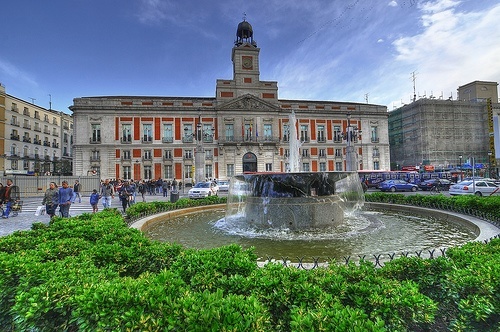
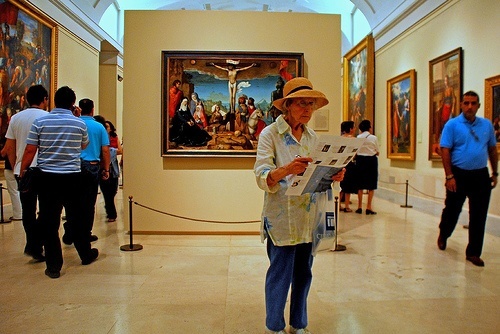
Two
more landmarks worth visiting are
the Plaza de Espana
with its
A few
miles northwest of
The
Roman aqueduct of
(photo
by Eric Titcombe used
under terms of Creative Commons license.)
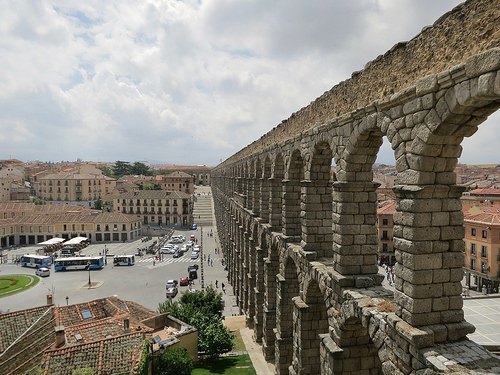
Twin
filagreed towers dominate the
ornately ornamented
facade of the Gothic cathedral of
Two
cities front the Bay of Biscay:
A
highlight of
Nineteenth-century architect Antonio Gaudi and his followers designed many fantastic buildings in the neo-Catalan style. Construction on the complex Church of the Sacred Family, begun in 1882, is still underway.
Book
stalls and well-known landmarks
line the Ramblas, a
succession of colorful avenues running from the waterfront to
(photo
by Antonio Gil used
under terms of Creative Commons license.)
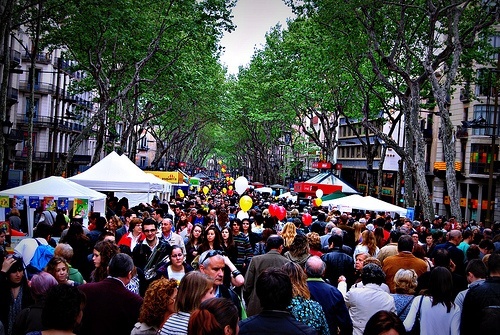
The
Ninety
miles off the coast of
the others. Mallorca, Minorca, Ibiza and Formentera have in common white-sand beaches and blue Mediterranean seas.
(photo
by Cristina E used
under terms of Creative Commons license.)
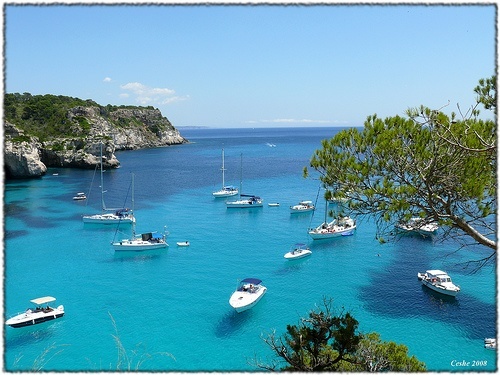
Fertile
orange groves and rice
paddies of La Huerta encircle
modern
(photo
by Juanma Alvarez used
under terms of Creative Commons license.)
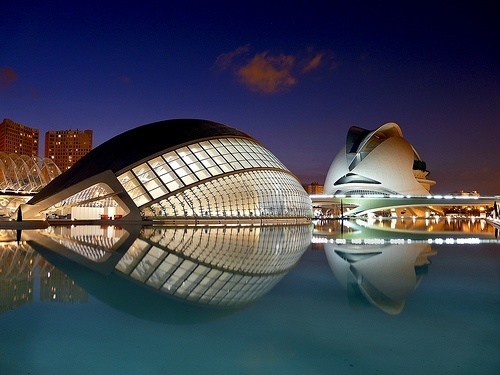
Beyond
(photo
by Hernán Piñera used
under terms of Creative Commons license.)
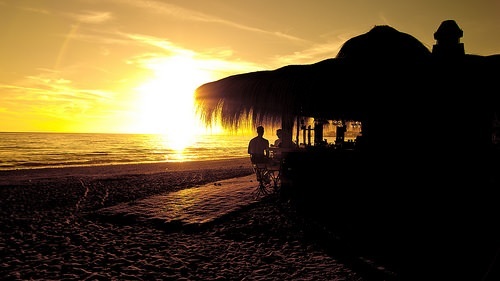
The
character of old
Ancient
fortifications on the
elevated Gibralfaro offer a
magnificent view, on some days as far down the coast as
The
Alhambra of Granada,
palace of sultans and their
harems, displays the honeycombed wood and stucco decorations of Moorish
artisans. Gypsies still perform flamenco dances in mansion like caves
situated
high on the hill of the Sacromonte.
(photo
by Jose Maria Cuellar used
under terms of Creative Commons license.)
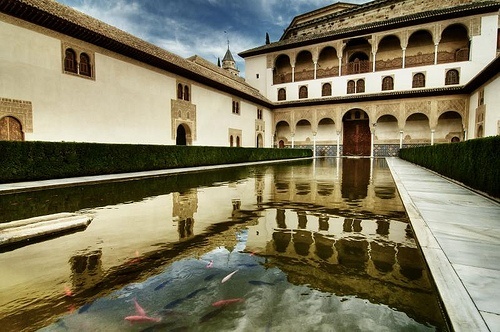
Two
monuments of
Narrow
streets and flower bedecked
patios retain
Gothic
and Moorish walls ring
Among
the priceless religious objects
stored in the
cathedral of
Best
Buys
Rivaled
but not surpassed by
Among the best buys are art and antiques. Dozens of galleries feature the output, especially paintings and graphics, of a highly professional art scene. Many antique shops specialize in a specific commodity such as glassware or ivory.
Spanish couturiers are recognized for fashionable designs sewn in suede and antelope.
Also in demand internationally are high-quality leather goods including gloves, handbags and shoes.
(photo
by Hunda used
under terms of Creative Commons license.)
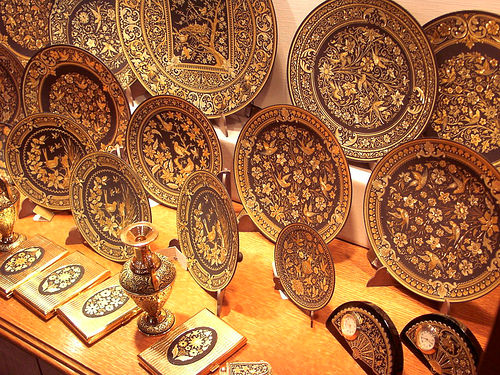
Even
though
Shops and boutiques, initially open from 8:30 to 1:30, reopen after lunch and do business until 8 or 9. They are usually closed on Sundays and holidays.
Department
Stores
Department stores offer the convenience of one-stop shopping along with a wide range of reliable goods.
Two
chains, Galerias Preciados and El
Corte Ingles, each
with several stores in
Celso
Garcia is the most exclusive of
Unlike some of the smaller shops, department stores maintain regular business hours and sell at fixed prices. Interpreters are generally on hand to aid non-Spanish speakers.
The
Rastro
(photo
by Hans Dinkelberg used
under terms of Creative Commons license.)
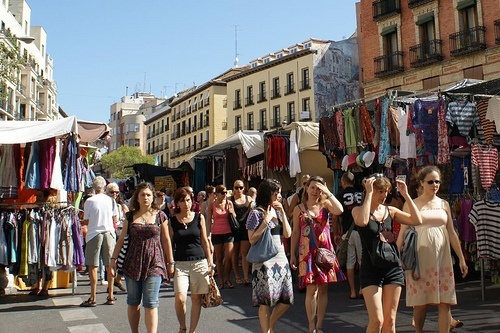
Buying aside, the fun lies in mingling with the holiday crowd. Vendors start clearing their stalls and locking up early, around 2 p.m.
Trains
Most
routes of the national Spanish
State Railways (RENFE)
radiate from
(photo
by Curimedia Photography used
under terms of Creative Commons license.)
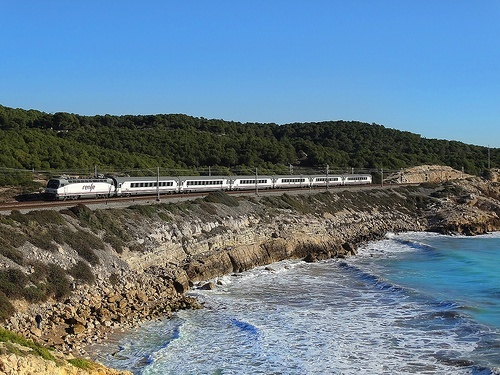
Rail fares are determined not only by the distance traveled, but also by the kind of train
traveled
on. Three kinds of express
trains- diesel TALGOS
and TERs and electric ELTs—charge a supplement per kilometer in
addition to the
regular fare. TALGOs link
RENFE sells reduced price tickets for extended travel to be completed within a certain period of time. Special Blue Day discounts in effect 306 days a year lower selected fares 25 to 50 percent. Reservations, which can be made 60 days in advance, are usually obligatory.
Most trains are equipped with snack bars or dining cars. By and large, railway personnel
speak only Spanish.
Bus
An extensive bus network, less expensive than railways, serves many places not accessible by train. Cities and larger towns usually have depots used by all bus companies. In hamlets without central depots, buses belonging to any of several companies may leave from different locations. Advance reservations are not required.
Planes
Iberia
Airlines, offering both
international and domestic
service, connects
(photo
by Pieter van Marion used
under terms of Creative Commons license.)
